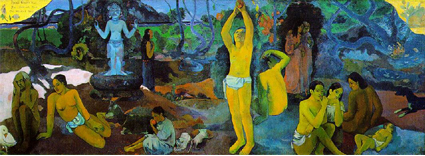To chime with the perennial New Year mood of soul-searching and taking stock, this week’s picture is Paul Gauguin’s monumental canvas Where Do We Come From? What Are We? Where Are We Going? It was painted in Tahiti, near the end of the artist’s long and peripatetic life, and is owned by the Museum of Fine Arts in Boston.
The picture has its origins in the artist’s decision to kill himself, in December 1897. His tropical paradise had turned out to be a chimera – not the Eden of his dreams, but a depressing island colony, its population decimated and its culture progressively denatured and ruined by the missionaries, alcohol and venereal disease imported by its French rulers. Gauguin was ill, unhappy and in debt. But before putting an end to his life he was determined to leave a testament to his most cherished beliefs, so he began work on the picture reproduced here. He described the fury of its creation in a letter:
“I worked day and night that whole month in an incredible fever… It is all done from imagination, straight from the brush, on sackcloth full of knots and wrinkles, so the appearance is terribly rough. They will say it is careless, unfinished. It is true that one is not a good judge of one’s own work, nevertheless I believe that this canvas not only surpasses all my previous work, but that I will never do anything better or even like it. Before dying I put into it all my energy, a passion so painful, in terrible circumstances, and a vision so clear, needing no correction, that the hastiness disappears and life surges up…”
As it turned out, Gauguin’s attempt at suicide failed. He took so much arsenic that his body rejected the...


